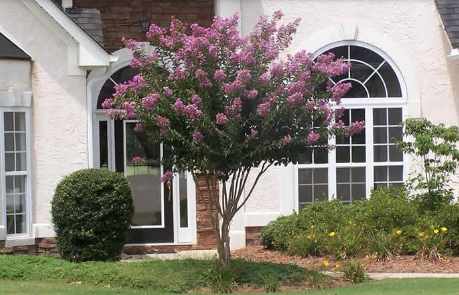
The Muskogee Crape Myrtle, also known as Lagerstroemia ‘Muskogee’, is a popular cultivar of the Crape Myrtle tree. It is a deciduous, upright-spreading large shrub or small tree with a vase-like crown. It was developed by the United States National Arboretum in Washington D.C and given the name of the native American Indian tribe ‘Muskogee’. It is a hybrid of Lagerstroemia fauriei and Lagerstroemia indica, two species native to Asia.
The breeding work that led to the creation of the Muskogee Crape Myrtle was aimed at producing a Crape Myrtle with improved resistance to powdery mildew, a common fungal disease that affects many Crape Myrtle varieties. The ‘Muskogee’ was hybridized in the early 1960s and was introduced to the market in the mid-20th century. This variety has become one of the most widely planted crape myrtles in the United States. It adapts well to U.S. Department of Agriculture plant hardiness zones 6 through 9.
It grows to a height of 15 to 20 feet with a spread of 12 to 15 feet. The tree is a fast-growing one, averaging 12 to 24 inches per season. Large crepe-papery lavender-pink flowers bloom in abundance from early summer through early fall. By autumn, flowers give way to small brown fruiting capsules. Four-inch long glossy dark green leaves turn a reddish-orange by fall. Flowers and foliage aren’t the only show, the bark is also eye-catching with its cinnamon color, which peels away revealing a shiny light gray.
Characteristics of Muskogee Crape Myrtle
- Size: The Muskogee Crape Myrtle can grow to be up to 20-30 feet tall, with a spread of 15-25 feet.
- Growth Habit: It is an upright-spreading large shrub or small tree with a vase-like crown.
- Growth Rate: It is a fast-growing tree averaging 12 to 24 inches per season.
- Bark: The bark is gray to tan and exfoliates with age.
- Flowers: The flowers are terminal inflorescences of crepe-papery, light lavender-pink flowers that bloom from early/mid-summer to early fall.
- Leaves: The foliage is glossy, with elliptic to oblong, dark green leaves (to 4″ long) that turn red-orange in fall.
- USDA Zone: It thrives in USDA zones 7 through 10.
- Lifespan: Mature specimens can persist for 50 years or more.
- Bloom Time: It blooms from early/mid-summer to early fall.
- Root System: Information on the root system is not specifically mentioned in the provided sources.
- Sun Exposure: Prefers full sun to ensure optimal blooming.
- Soil Requirements: Thrives in well-drained soil; tolerant of a variety of soil types including clay, loam, and sandy soils.
- Watering: Drought-tolerant once established but benefits from regular watering during dry periods.
Muskogee Crape Myrtle Cultivation
- Location: Choose a location that receives full sun, at least 6 hours per day. It thrives in sunny spots which promote better blooming and healthy growth.
- Soil: Plant in well-draining soil. While Crape Myrtles are adaptable to various soil types, they prefer slightly acidic to neutral pH levels. If your soil is heavy clay or too sandy, amend it with organic matter to improve drainage and nutrient content.
- Planting Time: The best time to plant is in the late fall or early spring when the tree is dormant. This helps the tree establish roots before the growing season.
- Spacing: Space the plants about 6-12 feet apart depending on the mature size and growth habit of the variety.
- Watering: Water the tree regularly during the first few years to establish a deep root system. Once established, the Muskogee Crape Myrtle is drought-tolerant.
- Fertilization: Fertilize the tree three times a year: once in spring, once in summer, and once in fall. Use a slow-release fertilizer with a balanced N-P-K ratio.
- Pruning: Prune the tree in late winter or early spring to shape it and remove any suckers. This will encourage new growth and maintain the tree’s vase-like shape.
- Disease and Pest Control: This tree is resistant to most pests and diseases. However, keep an eye out for powdery mildew, leaf spot, aphids, and scale. If you notice any issues, treat them promptly with the appropriate fungicide or pesticide.
- Winter Protection: In colder regions (zones 6-7), provide winter protection for the tree by wrapping the trunk with burlap or using a tree wrap.